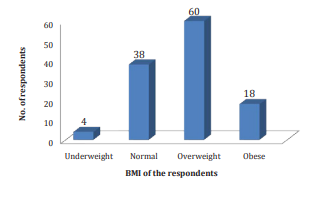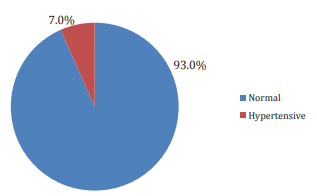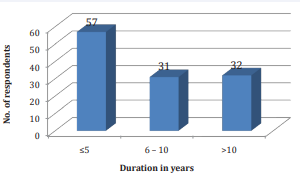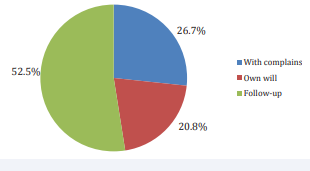A Study Method of Treatment Compliance in Regular Follow up, Routine Investigation and Complication Screening among Diabetic Patients Presenting in BPKIHS, Dharan
- 1. Department of Internal Medicine, BPKIHS, Nepal
- 2. Department of Public Health and Community Medicine, BPKIHS, Nepal
- 3. Department of Ophthalmology, BPKIHS, Nepal
Abstract
Background: Type 2 diabetes is typically a chronic disease associated with a ten-year-shorter life expectancy because of number of complications with which it is associated.
Objective: To find the association between treatment compliance (adherence in regular follow up, routine investigations and complication screening) and other related variables.
Method and materials: One hundred and twenty consecutive out-patients of internal medicine BPKIHS for follow up of diabetes who are diagnosed as diabetic for at least 1 year. Face to face interview was taken to fill the semi-structured questionnaire which included patients detail and information regarding regular follow up, routine investigations and complication screening.
Results: Out of 120 respondents, most were of age group more than 60 years with female preponderance76 (63.3%).60 (50%) respondents were compliant for follow up and reasons of missing the appointment were 21 (35%) reported due to poor accessibility, 19 (31.6%) reported lack of time, 15 (25%) reported being unable to come by oneself (geriatric patients), 4 (6.7%) reported financial problem and 1 (1.7%) reported ignorance about follow-up. 71 (64.5%) had some complications which are 47 (42.7%) had hyperlipidemia, 11 (10%) had diabetic retinopathy, 9 (8.1%) had nephropathy, 4 (3.6%) had neuropathy, 6 (5.4%) had cataract and 3 (2.7%) had glaucoma.
Conclusion: We found that the compliance in routine investigation (i.e.90.0%) and screening of the complication (i.e.91.8%) was much better than that in follow-up (i.e.50.0%).
Keywords
• Diabetes mellitus
• Compliance in regular follow up
• Routine investigation and complications
Citation
Shrestha JS, Shrestha A, Ghimire A, Baral DD, Lavaju P, et al. (2017) A Study Method of Treatment Compliance in Regular Follow up, Routine Investigation and Complication Screening among Diabetic Patients Presenting in BPKIHS, Dharan. J Endocrinol Diabetes Obes 5(1): 1096.
INTRODUCTION
The total number of people with diabetes is projected to rise from 452 million in 2017 to 642 million in 2040 [1]. About 1.1 million people were estimated to have died due to diabetes in 2005 and almost 80% of diabetes deaths occur in low- and middle-income countries and mostly people under the age of 70 years; 55% of diabetes deaths are in women [2]. There is a higher incidence of type 2 diabetes in urban than in rural areas [3], as well as incidence is associated with population whose lifestyle has changed from traditional patterns to a modern “Westernized” model [4].
Diabetes is an endemic disease in Nepal, and is bringing new challenges in connection with rapid urbanization and modernization [5]. A survey conducted in urban Nepal between 2001 and 2002 showed that 10.8% and 13.2% of males suffered from diabetes and pre-diabetes respectively, with the values for females being 6.9% and 10.2%, respectively [6]. The percentage of diabetic patients has increased from 19.04% in 2002 to 25.9% in 2009 in Nepal [7]. The data published in April 2011by WHO showed deaths due to diabetes mellitus reached 3,224 (2.17%) of the total deaths in Nepal [8].
There is higher prevalence of diabetes (diabetes was found in 7.5% of subjects) in people staying in Sunsari district, eastern Nepal [9]. The mean ages of all diabetics were 55.5 ± 14.4 years and 44.2 ± 11.2 years for the newly diagnosed subjects. The prevalence of diabetes increased with age. More diabetes was documented in overweight or obese than in underweight subjects [10].
MATERIAL AND METHODS
One hundred and twenty consecutive out-patients of internal medicine BPKIHS for follow up of diabetes who are diagnosed as diabetic for at least 1 year from 15th August to 15th October 2015. Face to face interview was taken to fill the semi-structured questionnaire (included patients detail and information regarding regular follow up, routine investigations and complication screening).The study entails a few minor risks. The patients may feel uncomfortable to give details about their adherence to the treatment. So the study and its goal and objectives were explained to the participants prior to the interview, after which informed written consent was requested.
Inclusion criteria
- Patient visiting OPD of internal medicine, BPKIHS for follow up of diabetes who are diagnosed as diabetic for at least 1 year
- Patients giving written informed consent.
Exclusion criteria
- Referred cases from other institutions
- Patients visiting for the first time
- Patients not giving consent
- Patients diagnosed as diabetic for less than 1 year duration.
HTN is defined clinically as SBP 140 mmHg or greater or DBP 90 mmHg or greater averaged over two or more readings on two or more visits following an initial screening [11]. According to World Health Organization (WHO) in 2002 the BMI standards for Asian populations [12].
Normal weight (18.5 to < 23.0 kg/m2),
A moderate-risk public health action point (23.0 kg/m2), and
A high-risk public health action point (27.5 kg/m2) (7).
In 2009, India’s health ministry adopted even lower BMI ranges for overweight (23.0 to < 25.0) and obesity ( ≥ 25.0) [13].
WHO criteria for diabetes are as follows [14]:
Fasting plasma glucose ≥ 7.0mmol/l (126mg/dl) or
2-h plasma glucose ≥ 11.1mmol/l (200mg/dl).
Despite the limitations with the data from which the diagnostic criteria for diabetes are derived, the current criteria distinguish a group with significantly increased premature mortality and increased risk of micro vascular and cardiovascular complications.
Missed follow up was defined who did not come for follow up for more than equal 3 months and less than one year
ADA recommended target according to 2016 guidelines are as follows [15]:
Pre-prandial blood glucose= 70-80 mg/dl
Postprandial blood glucose= < 180 mg/dl
HbA1c = < 7%
There was no time limit for the compliance of investigation.
All interviewed questionnaire were indexed and kept on file. Database was entered in MS Excel 2007 and converted into SPSS 11.5v for statistical analysis. For descriptive statistics, percentage, proportion, mean, Standard deviation, median, inter quotient range was calculated along with graphical and tabular presentation was made. For inferential statistics, χ2 , z or U was applied to find out the significant difference between gender, age, BMI and duration of disease diagnosis and treatment compliance (regular follow up, routine investigation and complication screening) at 95% confidence interval where p = 0.05.
RESULTS
The mean age of the subjects was 55.78 ± 10.33 years with maximum number of elderly age group (more than 60years) and female preponderance (63.3%) vs. male (36.7%) (Figure 1).

Figure 1 Gender distribution of the respondents.
The mean body mass index was 26.22 ± 3.79 kg per sq. m. with 31.7% normal weight, 50% overweight, 15% obese and 3.3% under weight (Figure 2).

Figure 2 Distribution of the respondents according to body mass index.
Seven percent of subjects were hypertensive with mean of mean arterial pressure (MAP) 94.44 ± 10.76 mm of Hg (Figure 3).

Figure 3 Distribution of respondents according to blood pressure.
47.5% had diabetes for less than 5 years, 25.8% for 6 to 10 years and 26.7% for more than 10 years (Figure 4).

Figure 4 Distribution of respondents according to duration of diabetes.
Follow up details of the respondents
50% respondents were compliant for follow up who reported to have missed no appointments, 23.3% missed less than two appointments in past one year and reasons of missing the appointment were as follows (Figure 5).

Figure 5 Reason for this visit.
35% reported due to poor accessibility, 31.6% reported lack of time, 25% reported being unable to come by oneself (geriatric patients), 6.7% reported financial problem and 1.7% reported ignorance about follow-up. When we asked the respondents why they have visited this time, 52.5% said it was follow up, 26.7% reported to have some complains while 20.8% said to have visited with own will (Table 1,2).
Table 1: Number of respondents according to age distribution.
| Age of respondents in years | Number | Percentage |
| ≤ 40 | 10 | 8.3 |
| 41 – 50 | 26 | 21.7 |
| 51 – 60 | 41 | 34.2 |
| > 60 | 43 | 35.8 |
| Total | 120 | 100.0 |
| Mean Age of respondents in years ± SD | 55.78 ± 10.33 | |
Table 2: Reason for noncompliance in follow-up and investigations.
| Reason for noncompliance in follow-up | Number | Percentage |
| Financial problems | 4 | 6.7 |
| Lack of time | 19 | 31.6 |
| Accessibility | 21 | 35.0 |
| Didn't know about followup | 1 | 1.7 |
| Geriatric patient | 15 | 25.0 |
| Total | 60 | 100.0 |
| Reason for noncompliance in investigations | Number | Percentage |
| No time | 3 | 25.0 |
| Accessibility | 2 | 16.7 |
| Didn’t know about investigation | 6 | 50.0 |
| Geriatic | 1 | 8.3 |
| Total | 12 | 100.0 |
Medications being used in respondents
42.5% respondents were having single oral hypoglycemic drug (OHA’s), 45.8% were having two OHA’s and 11.7% were having three OHA’s for glycemic control.79.2% were on metformin, 51.7% on Glimperide, 18.3% on Acarbose, 15.0% on combined metformin and glimperide and 2.5% on Sitagliptin.
24.2% respondents were on insulin while 3.3% were on two types of insulin simultaneously (Table 3).
Table 3: Types of oral medication being prescribed.
| Oral medications being prescribed | Number | Percentage |
| Metformin | 95 | 79.2 |
| Glimperide | 62 | 51.7 |
| Combination (metformin+ glimperide) | 18 | 15.0 |
| Gabapantin | 5 | 4.2 |
| Acarbose | 22 | 18.3 |
| Sitagliptin | 3 | 2.5 |
Among the respondents having medication added or switched (n=58), 36 (62.1%) said that their blood glucose level was not controlled adequately by single drug and 22 (37.9%) said there was no response to single drug.
Glycemic status in the respondents
13.3 % had their blood glucose level in non diabetic range, 12.5% in impaired glucose range whereas 74.2% in diabetic range according to WHO criteria for diabetes mellitus. The mean fasting blood glucose level was 147.28 ± 54.09 mg/d land mean postprandial blood glucose level was 242.29 ± 103.14 mg/dl.
When comparing the latest blood glucose level of the respondents with ADA recommended target level, 44.2% maintained the target fasting blood glucose level and 55.8% did not maintain the target. Similarly, 33.3% respondent maintained the target postprandial blood glucose level and 66.7% did not maintain the target.
While comparing the latest blood glucose level with past blood glucose levels (1 month back and 3 month back), 77.5% had no improvement or further derangement in blood glucose level i.e. bad progression and 22.5% had improvement in blood glucose level i.e. good progression.
Compliance for investigation in the respondents (Table 2)
Among 120 respondents, 90.0% did the routine investigation (blood glucose level) regularly or as prescribed and were compliant to investigation whereas 10.0% did not do investigations as prescribed and were noncompliant to investigation.
While asking the noncompliant respondents about reason for not doing the prescribed investigations, 50.0% said they didn’t know about the investigations, 25.0% said they didn’t have time for it, 16.7% said due to poor accessibility and 8.3% due to inability come by oneself (geriatric patient).
Compliance on screening for complications of diabetes in respondents (Table 4)
Table 4: Types of complication found in respondents who did screening.
| Complications found | Number | Percentage |
| Neuropathy | 4 | 3.6 |
| Retinopathy | 11 | 10.0 |
| Hyperlipidemia | 47 | 42.7 |
| Glaucoma | 3 | 2.7 |
| Cataract | 6 | 5.4 |
| Nephropathy | 9 | 8.1 |
| Total | 110 | 100.0 |
Among 120 respondents, 91.7%did screening for complications, thus are compliant and 8.3% did not do screening, thus are noncompliant on screening for complication. While asking the respondents who did not do screening about the reason, 30.0% said due to lack of time, 20.0% said they didn’t know about screening, 20.0% said they thought it was not important and 30.0% said they couldn’t come by oneself (geriatric).
Among the respondents who did screening (n=110), 64.5% had some complications via; 42.7% had hyperlipidemia, 10% had diabetic retinopathy,8.1% had nephropathy, 3.6% had neuropathy, 5.4% had cataract and 2.7% had glaucoma due to diabetes whereas in 35.5% respondents, no complications were found.
While considering the respondents who are compliant in follow-up, investigation and screening of complication as compliant respondents in treatment, 45% were found to be compliant and 55% were found to be noncompliant.
DISCUSSION
Out of 120 total respondents, 50.0% of respondents below 40 years, 46.2% of age group 41-50, 46.3% of age group 51-60 and 41.9% of age group above 60 years were compliant. 46.1% female and 43.2% male were compliant. There was no significance between gender and compliance (p value=0.761). In a study done by [16], showed that there was a slight predominance of males (54.1%) as compared to females (45.8%). This study reported a lower age of patients as compared to other studies.
Mean body mass index in compliant respondents was 27.02 kg/m2 where as noncompliant respondents was 25.57 kg/ m2 . The association between body mass index and compliance was significant (p-value=0.036).In a study by [17], showed overweight, obesity, hypertension, diabetes and proteinuria were found in 20%, 5.0%, 38.6%, 7.5%, and 5.1% respectively. Its shows preventive measures are required for weight reduction for better compliance of patients.
50% respondents were compliant for follow up who reported to have missed no appointments, 23.3% missed less than two appointments in past one year and reasons of missing the appointment were as follows: 35% reported due to poor accessibility, 31.6% reported lack of time, 25% reported being unable to come by oneself (geriatric patients), 6.7% reported financial problem and 1.7% reported ignorance about follow-up. When we asked the respondents why they have visited this time, 52.5% said it was follow up, 26.7% reported to have some complains while 20.8% said to have visited with own will. Similarly study done [14], showed non-adherence to appointment keeping was caused by forgetfulness, nature of work and busy schedules, travelling away from home, long clinic wait time.
43.9% of respondents were with disease duration less than 5 years, 32.3% between 6 to 10 years and 59.4% of respondents with more than 10 years were compliant. The association between compliance and disease duration was non-significant (p-value=0.094).
9.4% of respondents coming with complaints were compliant, 12% of respondents coming by own will were compliant whereas 76.2% of those coming for follow-up were compliant. There was significant association (p-value < 0.001) between the compliance of the patient and reason of the respondents to attend this visit.
40% of respondents on single medication, 41.1% of respondents on two medications, 52.2% of respondents on three medications and 83.3% of respondents on four medications were compliant. However, there was no significant association (p-value=0.192) between number of medicines and compliance. [18], showed two, three and four drugs were prescribed in 21.43%, 19.23% and 21.98%patients, respectively.
37.1% of respondents with uncontrolled blood sugar level were compliant; 60% of respondents with impaired blood sugar level were compliant and 75% of respondents with controlled blood sugar level were compliant. There was significant association (p-value=0.009) between compliance and latest control of blood sugar level.
Mean fasting blood glucose level in compliant respondents was 127.23 ± 32.62 mg/dl whereas in noncompliant respondents was 163.70 ± 62.31mg/dl. Mean postprandial blood glucose of compliant respondents was 200.67 ± 66.67mg/dl whereas of noncompliant respondents was 276.35 ± 115.04mg/dl. There was significant association (p-value < 0.001) between compliance and maintenance of both target fasting and postprandial blood sugar level.
38.7% of the respondents with bad progression of disease were compliant whereas 66.7% of respondents with good disease progression were compliant. There was significant association (p-value=0.010) between progression of disease and compliance.
Among 120 respondents, 79.2% were being prescribed with metformin, 51.7% with glimperide, 15.0% with combined metformin and glimperide, 4.2% with gabapantin, 18.3% with a carbose and 2.5% with sitagliptin. Among the respondents using injectable insulin (n=33), 57.6% were using insulin for less than one year, 36.4% for one to five years and 6.0% for more than five years. In study done by [19], 83% of subjects were on OHA, 9% on Insulin and 8% on OHA and insulin both. Similarly study done by [18],metformin accounted for 51.27% of the total anti diabetic medications followed by sulfonylurea 35.35%, insulin 7.96%, thiazolidinediones 4.78%, meglitinides and alpha glucosidase inhibitors 0.32%.The choice of anti diabetic depends on the type of patients, their concurrent illness, cost factors, as well as the availability of medicines. That’s why metformin is considered as a safer drug in terms of hypoglycaemia and hence to be preferred in our part of world.
Among the respondents who did screening (n=110), 42.7% had hyperlipidemia, 10% had diabetic retinopathy, 8.1% had nephropathy, 3.6% had neuropathy, 5.4% had cataract and 2.7% had glaucoma. The most common and frequent chronic complications were neuropathy 44.4% followed by cardiovascular and retinopathy 27.7%,nephropathy16.6% and others 11.3% according to study done by [19].
Limitations of the study
- Being a cross-sectional study, we could not compare the future prognosis of the patients who are compliant to treatment with those who are noncompliant. We had to limit our findings by only assessing the present condition of the patient and his/her compliance in the last one year.
- We could not include the adherence of patient to medication as a parameter to assess compliance due to poor reliability in verbal reporting of patient in this matter and lack of resources to undergo long term surveillance in individual basis.
- Since this study is OPD based study, we were unable to assess the status of patient who are not visiting OPD and are by default the noncompliant group. Hence, data on compliance we obtained from OPD will overestimate the compliance of general diabetic population in the community.
CONCLUSIONS
We found that the compliance in routine investigation (i.e.90.0%) and screening of the complication (i.e.91.8%) was much better than that in follow-up (i.e.50.0%). It was found that the majority of patients undergo screening for complication since it requires few visits to the hospital. Accessibility was the main factor; being geriatric age group who could not attend clinic by themselves and being unable to manage time were other key reasons of the noncompliance in follow-up. Similarly, ignorance about the investigation was main reason for noncompliance in investigation. For noncompliance in screening of complications, lack of time, geriatric age group and ignorance were equally responsible.









































































































































